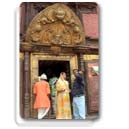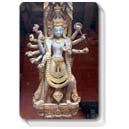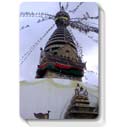White Water and Wooden Windows: Contrasting Images of Nepal, continued
 | Click to Enlarge. |
The higher water had heightened the flow and increased the intensity of the rapids. The whole morning was spent negotiating white water, including the infamous Jaws and Dead Man Eddy. At one point the entire raft went up on its side. Three of us were ejected out into the churning waves. Next thing I knew everything was black. I was under the raft. I tried to feel my way out but the raft was moving with me. I tried moving my hands in the opposite direction alongside the raft. Blue sky and air. Then I felt a tug. Will pulled me out of the water just as I was about to slam into the rocks. We hauled our other two team members back into the raft and recomposed ourselves for the next big run. As water careened in we paddled furiously, the waves tossing us like us a tiny rubber ducky. Wiped out but energized we made it to calmer water. We raised our blue paddles in a rafting high five and screamed, "Go Team King Fisher."
 | Click to Enlarge. |
After nine days of camping on the Sun Khosi we were pleased to return to the comforts of urban Kathmandu. Far from serene however, Nepal's natural extremes are matched by the contrasts found in the Kathmandu Valley. At any given moment beauty and ugliness occupy the same space. Ancient monuments sit next to heinous concrete block apartment buildings. Poverty, pollution and piles of waste share the corner with affluence.
 | Click to Enlarge. |
The Kathmandu Valley in the sixteenth century was divided into three thriving kingdoms, Bhaktapur, Patan and Kathmandu. Although only a few minutes drive from each other now, they were their own principalities. In each current day city, an ancient square, the Durbar Marg, still stands. Will and I spent over a week touring the ancient cities and their modern counterparts.
 | Click to Enlarge. |
Worn red bricks paved the streets. Five-story pagodas were adorned with intricate wooden carvings of the Hindu pantheon of gods. Bustling temples were gilded with gold, like icing on a wooden cake. Ruddy red brick palaces were decorated with elaborately carved metal doors and wooden windows. Adorned in a crisp bright sari a woman stepped out of her Mercedes to receive puja, a religious rite, at the corner gilded temple. A beggar, dressed in rags, waited in line behind her.
 | Click to Enlarge. |
In Bhaktapur, 55 intricate windows carved for the 55 wives of a previous king, peered out on the plaza below. Inside Kathmandu's Kumari Temple, a goddess still lives. She is a young girl who is worshipped by those that believe she can grant wishes. One day while stepping in the temple courtyard we spied her peeking out from behind her curtains. Outside the temple, street urchins clung to us asking for a few rupees.
 | Click to Enlarge. |
Beyond the temples and palaces, merchant buildings dating back as far as the 15th century stood. Brightly painted blue and yellow doors contrasted with the wooden windows and old brown brick. The ground below them had shifted, often times causing them to lean, but inside business was still being conducted. Metal smiths and wood carvers practiced the arts that have been passed down through the ages.
 | Click to Enlarge. |
We were lucky enough to meet one Nepali metal smith who had studied art in Wisconsin. He graciously took the time to explain his art and the various symbols embedded in his sculpture. Afterwards he invited us to his home for a typical Nepalese dinner of Dal Bhat. The hospitality and warmth we experienced while in Nepal was unmatched. At our home-away-from-home in Kathmandu, the Hotel Tenki, we became quite close with the staff and manager. We had long talks over tea and were genuinely sad to say goodbye.
 | Click to Enlarge. |
In Kathmandu's commercial district, just passed the Durbar Marg, worn concrete block buildings created the typical urban landscape found in most developing countries. Two-stroke tuk-tuks scooted by spewing filth. The polluted air hemmed in by the surrounding hills was stifling. There was no rubbish collection to speak of. The stench was often unbearable. The crush of people was overwhelming. Touts and beggars constantly approached selling their wares and looking for handouts.
 | Click to Enlarge. |
On Buddha Jayanti, Buddha's birthday, Will and I walked to Kathmandu's famous Swayambunath, the Monkey Temple, which sits on a hill overlooking the city. On the way we crossed a river that was no more than a sewage dump. Next to the river, a funeral and cremation were taking place. Mourners meditated next to the body.
 | Click to Enlarge. |
We climbed the steps to Swayambunath. A giant white stupa, topped with a gold cube decorated with the eyes of Buddha, and capped with a 13-stepped umbrella, stared down at us. Worshippers walked clockwise hypnotically spinning the multitude of prayer wheels. The smell of butter lamps and incense permeated the night air. A full moon hung overhead. The mood of the crowd was jubilant. Will and I joined in on the Kora, spinning the prayer wheels, participating in the mesmerizing festivities.
 | Click to Enlarge. |
Nepal is an enchanting and difficult country. Poverty, desperation, pollution and a lack of infrastructure frustrate every visitor. Yet the hospitality, culture, history, and outdoor pursuits provide adventure and interest for even the most jaded traveler. The extremes we experienced, both natural and manmade, made it easy for us to say goodbye, but at the same time ensured that we will return.
MKS
|
